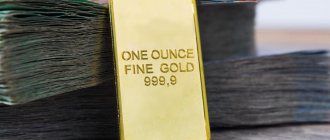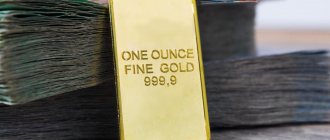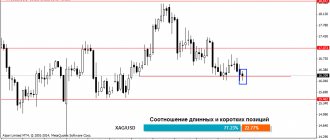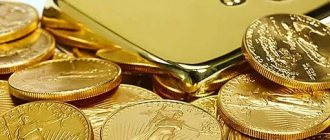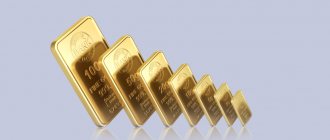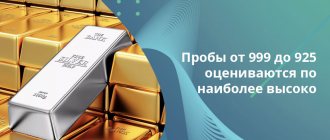Hello dear readers. I’m willing to bet that each of you is interested in the question of how to preserve your capital as reliably as possible in conditions of rapid inflation.
You don’t need to be a financial analyst to understand the need to withdraw funds from a rapidly depreciating monetary form into stable tangible assets, for example, precious metals.
Let's talk about how to store money in gold and whether it is effective in terms of generating income.
Basel III: the global financial revolution
On March 29 of this year, Basel III, developed by the Basel Committee on Banking Supervision, came into force, returning gold to its historical significance. In short, about 40 years ago, the same committee abolished the gold backing of the dollar, making US currency and Treasury obligations virtually the only valuable instrument in the world. How and why this happened is a long and dark story. Gold was simply turned from a universal equivalent into a market commodity, like oil or cotton. In bank reserves, gold can now be accounted for only at half its value, which means that it is unprofitable to purchase and store it, since it is possible to issue loans and money into circulation only at half its market value.
Despite this, today it is the US Central Bank that has the largest official gold reserves in the world - 8,133 tons. For example, Germany, second on the list, has more than two times less gold - 3,369 tons. Russia, with all of last year’s increase, ultimately has 2,119 tons of gold in its reserves. So, Basel III says that from now on gold is a full participant in group 1 of assets, equal to the dollar.
This means that the interest of states, banks and private investors in it should also increase. For example, instead of dubious dollars and treasury bonds of other countries, countries can store their entire funds in real, shiny, highly liquid bullion. In our own vaults, under full control, and not increasing the influence of other countries through demand for their currency and securities.
Experts explain the long-term decline in the value of the metal (from approximately 2012 to 2021) precisely by the global game in the market, through which prices were artificially lowered in order to buy large volumes at a low price - after all, the entry into force of Basel III was known already in 2011.
Investment
Investments in gold have been popular for many years. Such deposits are as reliable as possible, thanks to the perfect pricing policy. But this type of investment is characterized by a significant disadvantage. Compulsory medical insurance does not fall under the state insurance program.
Servicing such accounts is more expensive than regular and foreign currency accounts. Therefore, choosing a bank must be taken seriously.
Thanks to the calculator, users can keep their metal deposits under control. To obtain information, indicate the name of the metal, size, and period. The system makes instant calculations.
Is it profitable to invest money in gold?
But these are all big games, but what should an ordinary person do and why does he need gold? About the same thing that countries need: to preserve what they have acquired, to save money from inflation and devaluation. And precious metals are starting and winning here.
The table below shows the approximate value of gold and the dollar over a period of 21 years at various intervals. It can be seen that the 1998 crisis increased the price of the dollar by 4.5 times, and the increase in the price of gold due to two factors - the real exchange rate on the international market, and the increase in the price of the currency gave an increase of almost 10 times. In other words, if you invested equal amounts of rubles in the dollar and in gold, then after selling them after the crisis on gold you would have earned 2 times more.
During the 2014 crisis, the situation was a little worse: with a similar strategy, investing in the dollar would have been 20% more profitable than in gold, but during this period, as noted above, there was already a forced reduction in gold prices on the global market. In any case, the gain from investing is 1.8 times compared to the ruble. Let's calculate, on a very average basis, today's gold and dollar prices to the rates of the crisis years. And we clearly see that the ruble price of gold is growing stronger than the dollar!
| Assets | July 1998 | July 2006 | July 2008 | July 2009 | July 2011 | July 2012 | July 2013 | July 2014 | July 2015 | July 2019 | June 2021 to July 1998 | June 2021 to July 2008 | June 2021 to July 2015 |
| Dollar, rub. | 6 | 27 | 23 | 33 | 28 | 32 | 32 | 35 | 57 | 63 | 10,5 | 2,7 | 1,1 |
| Gold 999, rubles/gram | 60 | 560 | 710 | 940 | 1440 | 1650 | 1340 | 1450 | 2030 | 2840 | 47,3 | 4,0 | 1,4 |
| 999 gold, dollar/ounce | 260 | 654 | 950 | 937 | 1600 | 1571 | 1240 | 1300 | 1154 | 1413 | 5,4 | 1,5 | 1,2 |
Conclusion - investing money in gold for the long term is the most profitable option. Gold grows - profits grow, the dollar grows - the price of your gold still rises. The growth of gold combines with the growth of the currency and gives a good multiplier.
What are the advantages of compulsory health insurance at VTB?
In case of cooperation with VTB and opening a compulsory medical insurance, the user receives a large number of benefits.
The main ones are:
- no taxation on added value when purchasing precious metals;
- the ability to make changes to your personal portfolio;
- prompt solution to the problem of storing personal metals;
- a very simple and profitable procedure for purchasing and selling metals;
- the ability to make account transactions around the clock anywhere.
You can appreciate all the benefits after directly using the account.
Where to buy gold for savings?
1. The simplest option is to invest money in gold at Sberbank, for example, in unallocated metal accounts, the so-called compulsory medical insurance. In your personal account, the transaction can be completed in minutes, VAT is not assessed on purchases/sales, and the risk of losing treasure is minimal. In exchange for your money, the bank provides a statement stating that you are now the owner of so many grams of precious metal. Virtual gold can be purchased in small quantities, stored for as long as desired, and sold at any time at the current rate. You can also “withdraw” your bullion from your account, but the commission will be significant: for example, at Sberbank for a 1-gram piece - 600 rubles (more than 20% of the price), for 100 grams - 2520 rubles (about 10%).
In fact, with such a price for the “materialization” of the metal and the arbitrary establishment of the purchase/sale rate, impersonal gold for banks is nothing more than a means of attracting investor funds, like a deposit, but the interest on which is not fixed and the funds are not insured.
In addition to the commission upon receipt, the large difference in purchase and sale rates, the lack of insurance, the disadvantages include the fact that interest is not accrued on funds for compulsory medical insurance, all profit or loss is determined solely by changes in the world price of gold and the exchange rate of a particular bank. So, at the time of writing, Sberbank was selling gold at a price of 2993 rubles/gram, and buying it back at 2720 rubles/gram. The spread is about 10%.
Another significant disadvantage: when selling metal, you must file an income tax return and pay income tax on profits if the unallocated metal was owned for less than 3 years (13% for residents). But you can take advantage of a property deduction of up to 250,000 rubles.
Let's consider a real example: the difference between the price of gold sales by Sberbank over the year was about 20%. But the difference between the sale price and the buyback is only 9%. Essentially, for the compulsory medical insurance account holder, this is a return on investment. Let's subtract personal income tax and get a little less than 8% (personal income tax is not taken into account when owning virtual metal for more than 3 years). The maximum interest rate on a deposit for that period in the same Sberbank was about 7%. That is, over the past year, those who invested in compulsory health insurance would have gained a little - about 1%. But a year earlier, a similar investment would have brought less than any contribution - only about 1% per year.
2. The second option seems more reliable - buy gold coins and bars in banks. But! In Russia, an individual can purchase bullion from precious metals only within the banking system. When purchasing, VAT is added to the cost of the bullion in the amount of now 20%, and when selling back to the bank, VAT is not returned to the individual. That is, in addition to the difference between the purchase and sale prices, there is a 20% tax. The government is once again discussing the abolition of VAT on investment gold; if it passes, the bullion will become a popular alternative to the dollar and euro, demand will increase, which will again increase its price. Due to commissions, real gold is more expensive than virtual gold, and here you need to have good faith in its success or consider significant time horizons.
3. The author still likes the third option - buying retail gold - jewelry (rings, earrings, chains, bracelets, etc.). Both decoration and investment. Only the price per gram in a jewelry store is much higher than the price of pure metal... Where is the benefit? Indeed, the price of the product already includes the painstaking work of the jeweler, the entire sales network, and often the weight of the stones.
The price of unredeemed collateral in a pawnshop is closest to the market price. Gold pledges, which are usually used, can be sold by a pawnshop only to two places: to ordinary citizens or to factories at the price of scrap. Therefore, the price per gram here is the most adequate, one might say, equal to the world price. So, you can find pawn shops with a price of 1,700 rubles per gram of 585 purity - that’s 2,900 per gram of the purest yellow metal. Almost the world market price. If necessary, this gold can again be handed over to a pawnshop or purchased at a lower price - the market average is 1500-1550 rubles. That is, the purchasing commission - the difference between the price of a one-time purchase and sale - will be about 8%. For comparison: in the case of currency, the difference in the rates of one-time purchase and sale is about 4%.
And finally, a chart of gold prices over the past 20 years. Let's remember it this way and follow the new history of ancient gold after Basel III comes into force.
Gold price chart for the last 20 years Source: mfd.ru
Features of compulsory medical insurance operations at VTB
The bank has some features of servicing impersonal accounts. These include:
- the smallest purchase and sale amount for silver is 1 g, for palladium, platinum or gold – 0.1 g;
- there is no minimum minimum balance;
- no charges on the balance;
- all operations are carried out without physical delivery of metal;
- the period of validity of the agreement is not limited;
- all actions are carried out in accordance with the bank’s tariffs;
- the safety of funds in an impersonal account is not subject to the law on insurance of investments of individuals.
When concluding a contract, it is worth considering each of the points.
What is the benefit?
Compulsory medical insurance brings significant profits to people if they manage their investments correctly - buy and sell metals on time. On the VTB 24 website you can always find out the profitability of all types from the group of impersonal metals. To do this, you need to open the compulsory medical insurance profitability calculator and look at the graph displayed for each type of metal. By entering a time frame and selecting a bank product, you can trace the price growth curve and determine for yourself the value of the proposed purchase, as well as derive patterns about changes in the level of profitability.
conclusions
VTB 24 Bank, starting from October 1, 2021, stopped opening impersonal metal accounts. Clients who opened such an account before the specified date continue to be serviced by the bank in the prescribed manner without changes.
Compulsory medical insurance is not a simple deposit; with this deposit you need to constantly monitor the price growth curve and have an idea of the future changes in the cost of selling and purchasing metal in order to correctly calculate your money and make a profit.
Often, to achieve the desired result, you have to wait stubbornly for a couple of months, or even more - several years.
Ingots
Gold bars of different weights can be purchased at branches of large banks. Most banks do not encourage the client to store a gold bar at home to avoid loss of marketability.
When storing in a safe deposit box, the bank will charge a separate fee for this. Also, upon purchase you need to pay VAT, which is not refundable in the future. When selling an ingot that was purchased less than 3 years ago, you will have to pay personal income tax.
Compulsory medical insurance: pricing policy
VTB Bank offers its clients to open accounts for the following precious metals:
- gold;
- silver;
- platinum;
- palladium.
Metals are extracted constantly, due to which reserves are replenished. The price policy for metals is determined by London, which sets the international exchange rate twice a day.
The rate that Russian banks take into account is set by the Central Bank. VTB forms the internal exchange rate, taking into account data from the Central Bank and internal reserves.
Thanks to the VTB personal account, users can track all quotes for precious metals, carry out instant purchase and sale transactions, and track analytics on deposits. The user independently keeps records of tax payments for transactions with metals.
Other differences
Friend or foe
Finex is a foreign organization. Registered in Ireland.
The fund from VTB is Russian.
FXGB is an ETF. VTBG - BPIF (sometimes called Russian ETFs). At first glance there is not much difference. But investors need to know that the requirements for ETFs are more stringent. They are more regulated. This affects the quality of management (for the better).
With BPIF, everything is simpler (it’s not for nothing that Russian banks and other management companies issue BPIF, not ETFs). There are essentially no special complex requirements. Which is what they actually use. Without even bothering with self-tracking. Acting as a bridge between investors and foreign funds.
Share price
The creators of VTBG probably knew that in terms of management costs, they were losing to their competitor. Accordingly, even without advertising double expenses, most investors will see (know) where it is cheaper. And in this regard, of course, real VTBG commissions are not the fund’s strong feature.
The guys decided to take others. We made the cost of one share on the stock exchange 1 ruble. For comparison, FXGD shares are currently trading at 820 rubles.
Many will take, although expensive in terms of expenses, but cheap in price , a fund from VTB “for change”.
“There are a couple of hundred (or even a couple of tens) rubles left in the account. You can't take anything with this money. Oh, no. Well, there is a penny-ruble gold fund VTBG. Beauty!"
